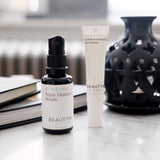
At home peels can make for more attractive skin because of the many benefits they provide: Restoring your glow, smoothing skin, fading fine lines, and improving skin texture. Incorporating an at home peel into your skincare routine can help you see results without irritation -- or the need to go to your derm's office every week.
Why You Need to Exfoliate
While your skin may present a unified front, the truth is that it's made of many layers. In a perfect world, your skin would quickly turn over the skin cells that died to make room for new, shiny ones. However, sometimes this doesn't occur as fast or as well as you would hope.
If you don't exfoliate regularly -- or exfoliate with effective ingredients -- you may see the following symptoms in your skin:
- Appearing dull when you look in the mirror
- Feeling dry or uneven in texture
- Having your makeup not go on as evenly as it used to
- Your skin appears flaky, but is not necessarily overly dry
These are just some of the examples of what can happen when you do not exfoliate.
The In-Office Peel
Chemical peels have long been one of the go-to procedures for dermatologists. Peels involve using different types of chemicals to penetrate and peel away layers of skin to reveal younger-looking, more even skin underneath. While some in-office peels are deep and can require as much as three weeks of downtime, a far more popular yet still potent option is the refreshing "lunchtime" peel, such as that offered at the BeautyRx Peel Bar.
These peels are the kinds that are still strong enough for instant results, but that are quick enough to be applied on a lunch break, yet gentle enough so there's no downtime or irritation, just gorgeous, glowing skin. Due to the strength of these peels, they are administered only by professionals and not for at-home use.
One of the most common ingredients in a lunchtime peel at a dermatologist's office is glycolic acid. This alpha hydroxy acid exfoliates the outermost layer of skin cells so that fresh, new skin cells can be brought to the surface. Glycolic acid peels can smooth the skin, reduce the appearance of fine lines, and make the skin appear "fresher" and radiant.
The At Home Peel Solution
Sometimes your skin needs a little extra TLC and pampering, and that doesn't always have to happen at a spa or dermatologist's office. At home peels are available without a dermatologist's prescription, yet still offer skin-brightening and smoothing properties. They can be used on their own or as the perfect maintenance regimen for use between in-office peels.
The Progressive Peel from BeautyRx is an example of an at home peel derived from Dr. Schultz's in-office peel treatments. A key differentiator between The Progressive Peel and other options is that you can use The Progressive Peel on a daily basis to experience results (and you don't have to go through years of medical school to correctly use it). The six-week system is designed for daily application so you can slowly build up the concentration of glycolic acid to achieve maximum results at home without any side effects.
Remember that not all peels are intended for daily use. The Progressive Peel incorporates glycolic acid that is uniquely buffered, or packaged in a way that delivers ingredients to the right location in your skin without irritating it. The controlled delivery system ensures even results across your entire face, which evens skin tone and reduces dryness.
The Progressive Peel is the perfect options for those who don't want to step foot in a dermatologist's office or visit a professional environment like The BeautyRx Peel Bar. Plus, its fool-proof progression plan allows you to boost your results over time without the downtime or irritation many peels can cause.
Resources:
Beta hydroxy acids. (2014, March 9). Retrieved from http://www.fda.gov/Cosmetics/ProductsIngredients/Ingredients/ucm107943.htm
Farage, M. & K. Miller, P. Elsner, H. Maibach. (February 2013). Characteristics of the Aging Skin. Advanced Wound Care. 2(1): 5-10.
Lazare, J. (September/October 2012). Careful Attention to Aging Skin. Aging Well. 5(5). P. 18. Retrieved from http://www.todaysgeriatricmedicine.com/archive/091712p18.shtml
Schultz, N. (2009, August 18). The difference between glycolic and salicylic acid. Retrieved from http://www.dermtv.com/difference-between-glycolic-and-salicylic-acid
 BRX REWARDS
BRX REWARDS




















Leave a Comment